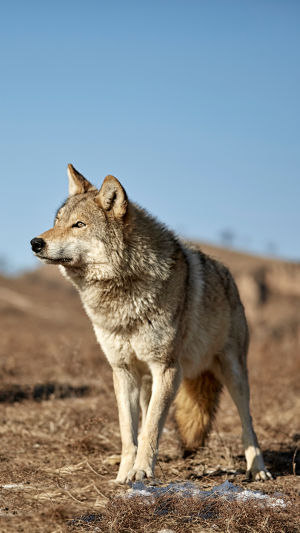The wolf is one of the most developed and successful large carnivores in the world. It has extraordinary speed, and energy, a wealth of howl messages and body language, and a very developed sense of smell.
They live and survive together and cooperate with each other to nurture and educate their offspring.
Its morphological characteristics.
The grey wolf is the largest wild species of about 41 canids, with a total length of 1000-1300 mm from tip to tail in males and 870-1170 mm in females.
Tail length 350-520 mm. Male wolves weigh 30-80 kilograms, with an average of 55 kilograms, and female wolves weigh 23-55 kilograms, with an average of 45 kilograms. The distance from the sole of the foot to the shoulder is usually between 60-90 cm.
The size of its body depends mainly on the geographical location, and the distribution period varies greatly. The higher the latitude of the distribution, the larger the size of the gray wolf.
As mammals, wolves are the top predators. When it comes to the wolf, everyone thinks of its howling and running speed. So do you know how high the IQ of wolves is?
The IQ of a wolf is generally equivalent to that of a human being over 2 years old, but some wolves are relatively stupid, depending on what kind of wolf it is.
The following knowledge points about wolves will let you know more about them.
1. A pair of wolves usually stay together for life, establishing and maintaining relatively complex family relationships. An average pair of wolves can have 4-6 pups.
2. When wolves growl at each other, they are harmonious. When you hear a wolf howl, there are actually more wolves involved than you might think.
Wolf howls are used for communication, lone wolf howls are to attract the attention of other wolves, and pack wolf howls may be to convey territorial information.
3. The average lifespan of a wolf in the wild is 13 years (usually 6 to 8 years) and up to 16 years in captivity.
4. Unlike other animals, wolves have a variety of different facial expressions for communication and group unity.
5. Wolves run on their toes to help them stop quickly and keep their claws from wearing out. Wolves can swim distances of up to 13 kilometers with the help of small nets between their toes.
6. Wolves have about 200 million scent cells, compared to about 5 million in humans, and wolves can smell other animals 1.6 kilometers away.
7. Young wolves are born with blue eyes, and their eyes don't turn yellow until eight months later.
8. The food composition of wolves is very complex, and all animals that can be caught are their food, including birds, amphibians, and small animals such as insects. Wolves also occasionally eat plant foods. They can eat a lot, 10-15kg of food at a time.
Have you ever come into contact with such a terrifying animal?





